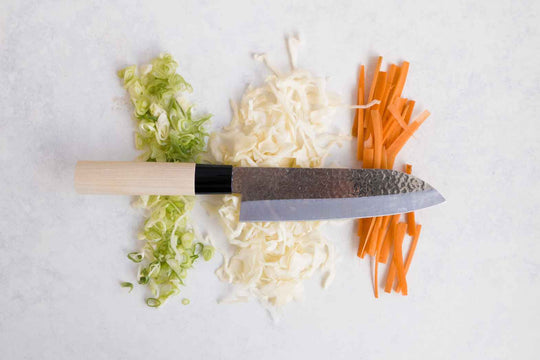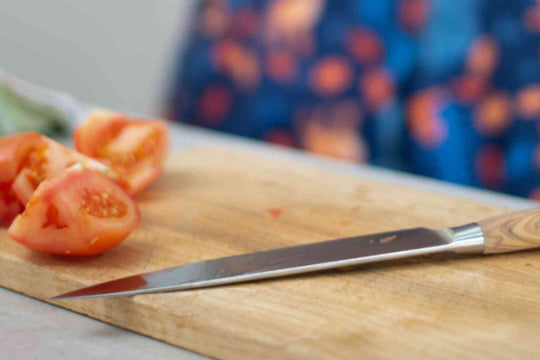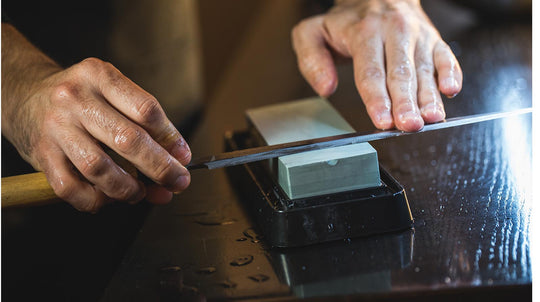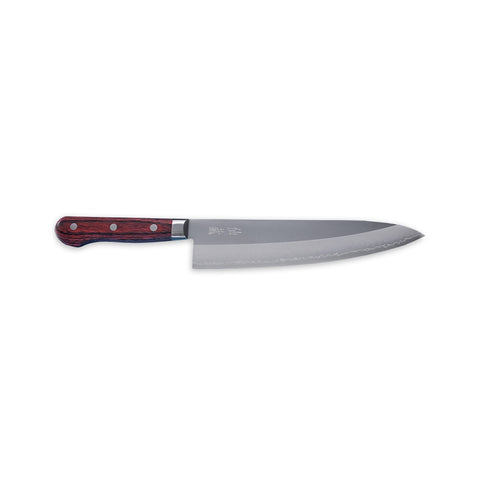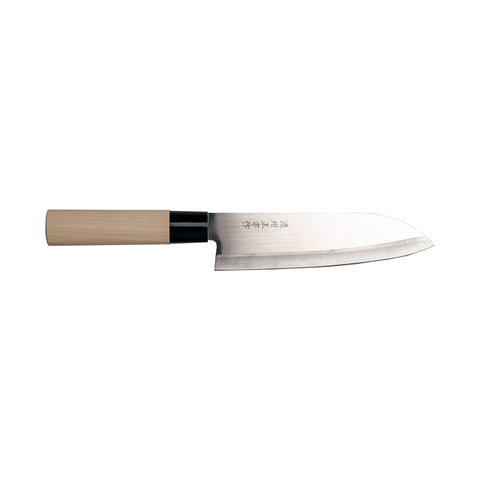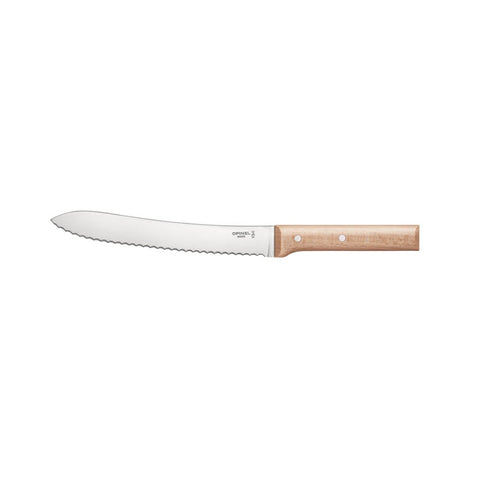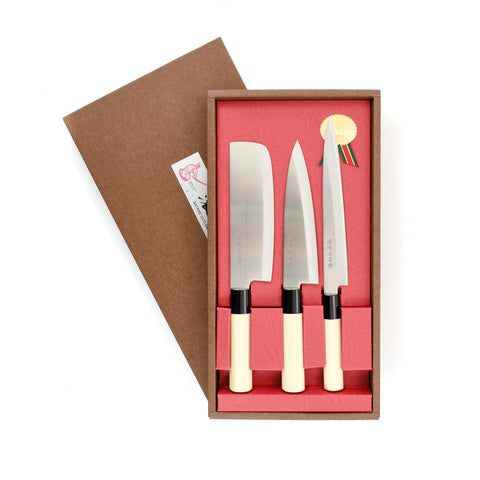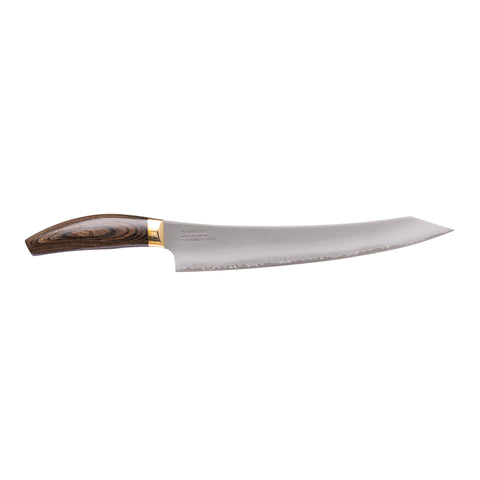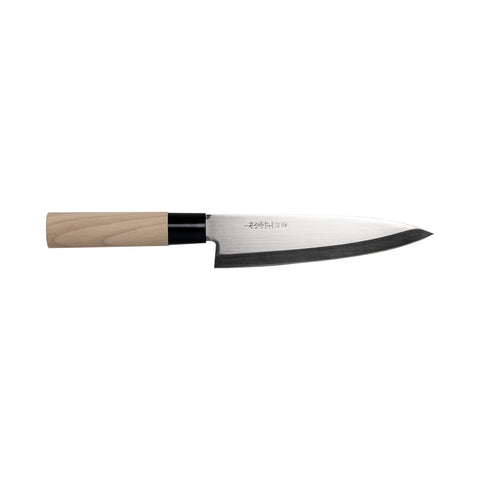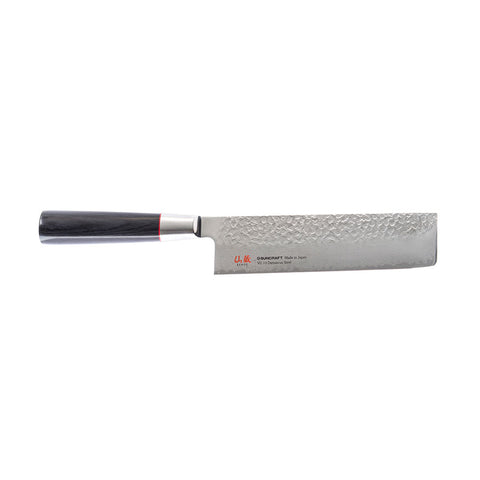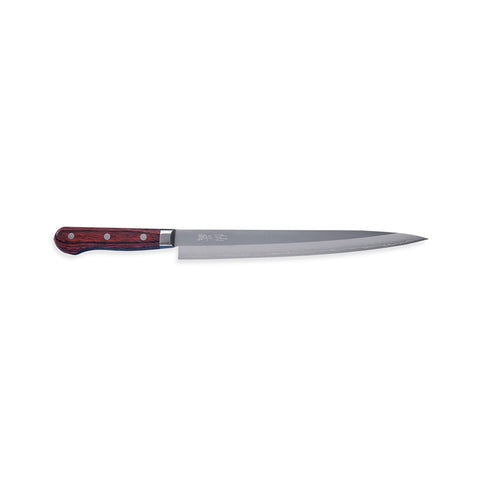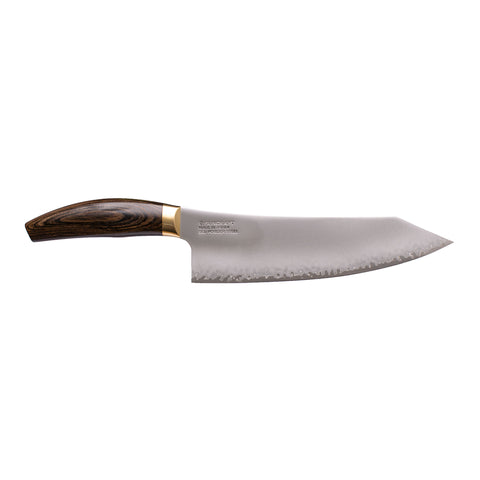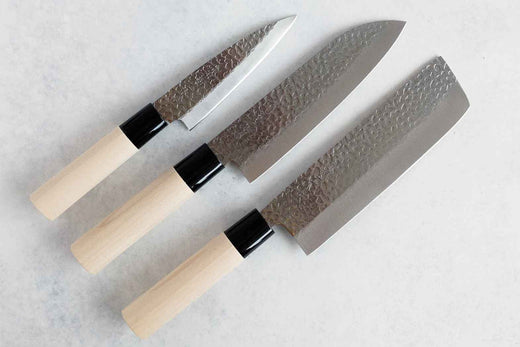
The Ultimate Guide to Kitchen Knives


Kitchen knives are an essential for every cook - they’re the one tool that you need to prepare any dish, from the simplest of fruit salads to Japanese noodle soups to delicate patisserie. There are so many different factors to consider when buying a new knife, starting out your collection or learning more about how to care for your knives.
Different Types of Kitchen Knives
-

Chef's Knife
Chef’s knives are for dicing, slicing and chopping small to medium-sized ingredients such as herbs, vegetables, cheese as well as fillets of fish and meat. It will likely be your most used all-rounder knife. Perfect for that rocking chopping motion.
-

Santoku Knife
Santoku roughly translates to three virtues, and you would normally use this for cutting meat, fish and vegetables. Santoku has a more straight blade than a chef’s or gyuto knife which allows for a more up and down cutting motion. It has the same uses as a chef's knife so it's up to personal preference which one you like best.
-

Utility Knife
A utility knife are something in between a paring and chef’s knife. Shape and size can vary a little, sometimes they look like a large version of a paring knife with a narrower blade, sometimes they have a slightly wider blade and resemble a small chef’s knife more. They are great for medium sized jobs, like chopping shallots or other things where a chef’s knife feels too big.
-

Paring Knife
Paring knives areare for peeling and slicing fruits and vegetables as well as intricate tasks such as removing the eyes from potatoes or segmenting citrus fruit. You also sometimes get serrated paring knives(occasionally called tomato or sausage knife). They are great for easily cutting through the skin of tomatoes and sausages, as you can hear from the name.
-

Boning Knife
Boning knives have a very narrow blade and sharp point that means you can manoeuvre your knife around the bones with ease. Use them to remove the bones from poultry, fish and meat.
-

Bread Knife
Bread knives are serrated - perfect for slicing bread and cakes as well as ingredients with hard skins such as a pineapple.
-

Carving Knife
Carving knives have a smooth blade that glides through cooked and cured meats.
-

Filleting Knife
Filleting knives are excellent for filleting fish, as you can hear in the name. They have a flexible blade that means you can push the blade against your chopping board to make sure you get all the skin off your fish, without taking off much, if any, meat. They are also great for filleting/deskinning tomatoes.
-

Steak Knife
Steak knives have smooth, study handles and either serrated or flat blades. Using steak knives makes light work of slicing through meat.
How many kitchen knives do I need?
This is all down to your personal needs and preferences. If you are building your kit from scratch, start with a chef's knife, a paring knife and a bread knife. From there you can build your knife collection based on what you use, and what you cook in your kitchen. You might want to add a couple of different sized chef’s knives. Or complement with a Santoku for a different shape. You might love using your paring knife and want more of the same, or a couple of different sizes. Or adding a filleting knife if you eat and cook a lot of fish.
What are material hardness and sharpening angles?
Material Hardness
The hardness of the steel of a knife is measured in something called the Rockwell scale, shortened to HRC. Knives generally range from about 52 to 58, with some very premium knives going as high as 64. The higher the number the harder the steel. A harder steel will keep a sharp edge for longer, however, on the flip side, it will be more work when you sharpen it to get the edge back. Whereas a softer steel needs to be sharpened more often, but it will be very easy to get that sharp edge back.
Sharpening Angles
You tend to get two options for the angle the blade is sharpened to. Western style knives have previously been sharpened to about a 22 degree angle, and Eastern knives to about 15-16 degrees. Although you will likely find that many knives, both Western and Eastern style knives are often sharpened to about a 15 degree angle nowadays.
The finer angle of an Eastern style knife is because of the cuisine that is often cooked in that area of the world. Softer vegetables and meats. And in the western world people often eat more root vegetables and tougher meats, and you may need to cut through bones. So a slightly wider angle will make the knife more robust and suitable to the cuisine in that area of the world.
Common Kitchen Knife Blade Materials
Stainless Steel
Stainless steel is the most common material that you will see in a kitchen knife. This is because it is one of the more affordable options. It is a durable, rust and stain-resistant material that is easy to sharpen but since it isn't as hard as damascus steel you may need to sharpen it more regularly.
Damascus Steel
Damascus steel has quickly become popular over the last couple of years, it's made by folding two types of metal together which is also what creates the classic patterns you can see on the blade. Most commonly they have a carbon steel core with layer of stainless steel outside. They are easily identifiable by their patterned appearance which happens during the forging process. They are both tough, durable, resistant to wear and able to sharpen to a fine edge - which is what makes this material just so popular.
Carbon Steel
Carbon steel knives are a little more rare and require different treatment to other metal blades. They are a type of stainless steel that is more susceptible to rust but, they are also easier to sharpen. You need to keep the knife dry and regularly....
Ceramic
Perhaps now a little old-fashioned you do occasionally see a ceramic knife. Compared to other materials they are much more lightweight yet can be sharpened to a fine edge. However they are more brittle and prone to chipping if used incorrectly or sharpened without the proper ceramic tools.
Forged, stamped or cut - which production method is best?
Stamped or cut knives are stamped or laser cut out from a sheet of metal, and after that shaped and sharpened to get your desired finished product. Stamped or cut knives are generally lighter than a forged knife. Forged knives are forged/hammered into shape from a solid piece of metal. The metal is heated up, and then forged and shaped, before it is sharpened. Forged knives are often heavier, and tend to have a full or partial tang.
The process of making a forged knife is more time consuming and labour intensive. So forged knives tend to have a higher price ticket than a stamped knife. Although with todays technology, a stamped knife doesn't mean bad quality, there are a lot of other factors to think of when buying your knife. And the most important thing is that you get a knife that works well for you.
Common Kitchen Knife Handle Materials

Wood

Plastic

Composite

Metal
Kitchen Knife Producers
-

Messermeister
Messermeister have been producing the highest quality steel knives since 1981. The name ‘Messer’ meaning knife and 'meister' meaning master, is indicative of the premium, hand-crafted blades they have been producing for decades. Now a female-owned company, Messermister continues to make quality and sustainably-sourced knives that are loved by professional chefs and home cooks alike.
-

Arcos
Arcos knives are made in Spain using the highest quality sustainable materials and carefully perfected manufacturing processes. They use a uniquely formulated Nitrum stainless steel for their blades to create knives with increased hardness, greater cutting power and a longer-lasting edge. And all the wood for their handles comes from FSC approved forests before being packaged 100% recyclable materials.
-

Senzo 33
The Senzo 33 layer knives are high quality Japanese chef knives. Superb quality ultra-sharp blades with a stunning aesthetic. The Senzo knives have a VG10 core which is one of the most popular stainless steels among professional chefs – they covet its hardness, ability to hold an edge and its resistance to rust. The blade has been cold forged under extremely high pressure, for a denser, tougher blade overall.
-

Seki
Seki knives are made in Seki City, Japan, which is renowned for being the knife capital of the world. Many cities have tried to claim this crown, but Seki City’s history of producing the finest quality knives for almost 800 years means it still reigns supreme in the Japanese knife industry.
-

Opinel
French knife makers, Opinel, are particularly famous for their folding pocket knife. And Opinel's high-quality kitchen knives are starting to prove just as popular. Their Parallele range is elegant, functional and makes even the most everyday cooking task a joy. And it’s not just the kitchen – Opinel’s expertise extends to the great outdoors with tools for gardening and foraging.
Glossary of terms
Butt: The back end of the knife’s handle, see our infographic above.
Full-tang: when the tang extends all the way to the end of the handle
Granton edge or scalloped edge: This refers to the chopping edge of the knife that has curved circles. It stops a vaccuum from being created when chopping food so it can more easily slide off the knife.
Half-tang: when the tang extends part way through the handle but not to the end
HRC: Refers to the hardness of the knife on the Rockwell scale. See above on material hardness for more info.
Rivet: The metal circles you see on western style knives. They secure the tang to the handle.
Serrated edge: A serrated edge is what you will most commonly see on a bread knife. It helps to slice through surfaces that are tougher.
Spine: The part of the blade that is opposite the edge. It is the thickest part of the blade. It can be used to apply pressure when using certain cutting techniques.
Tang: The part that extends from the blade into the handle.
Popular Kitchen Knives
FAQs
How many kitchen knives should I have?
If you are just starting your knife collection, there are a few essentials that will cover most basic kitchen tasks:
Paring knife: for topping and tailing vegetables, and prepping small ingredients
Chef's knife: a larger knife, for chopping bulky root veg, dicing and cross-chopping herbs or finely-diced meat.
Bread knife: for tomatoes or bell peppers that have a shiny, slightly tough skin.
What are the different knife capitals of the world?
A lot of places around Europe and the world are known for their production of knives. Many people hold them as the only place to buy knives from. Seki & Solingen are the most well known knife capitals of the world. And it's often seen a sign of high quality when knives are made in any of those two cities
Seki, Japan
Tradition of making Japanese knives dates back to almost 800 years ago.
Solingnen, Germany
What is the difference between a chef’s knife and a santoku knife?
Santoku has a more straight/flat blade than a chef’s/gyuto knife which allows for a more up and down cutting motion, rather than the rocking motion we may be most used to here in Europe. It will do all the same things as a chef’s knife, and it’s your preference which shape you like best. Santokus tend to have shorter blades than the average chef’s knife. You will generally not find a Santoku with a blade longer than 18cm.
